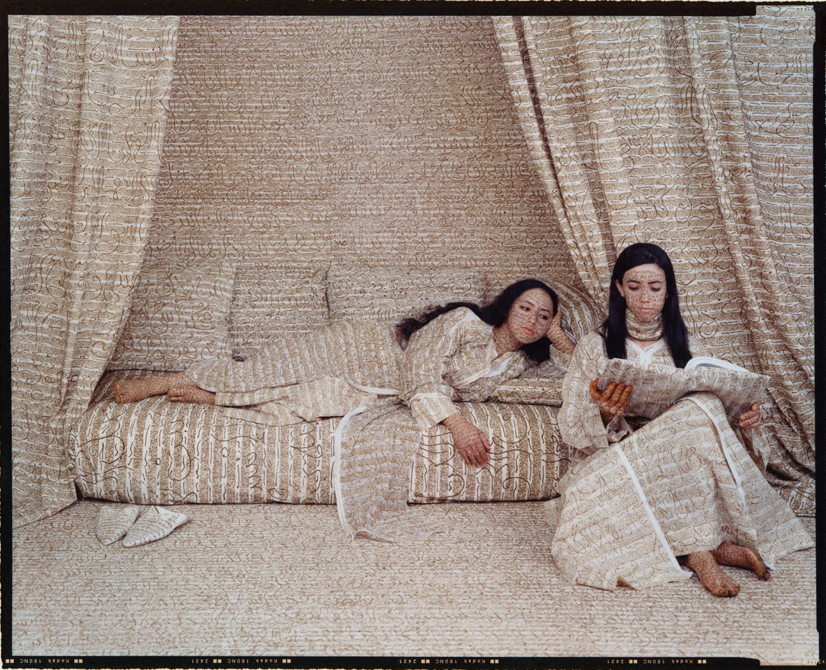
Arab female identity in Lalla Essaydi’s 'Image and Text'

Moroccan artist Lalla Essaydi appropriates traditionally male Islamic art practices and motifs with European Orientalist paintings to illuminate an otherwise stagnant image of the exotified Arab-Islamic female figure.
In a new exhibition at The Patricia & Phillip Frost Art Museum in Miami, Florida, titled Lalla Essaydi: Image and Text, architecture, calligraphy, and painting collide on her carefully composed photographs recently donated to the museum, featuring works from the artist’s Converging Territories, Les Femmes du Maroc, Harem, and Bullets series.
"Basing her work on the deconstruction of homogenous, eroticised images of Middle Eastern and African women and places plucked from the imaginations of European nineteenth-century painters, she [Lalla] illustrates private, gendered spaces in a nuanced fashion"
Essaydi grew up in Morocco, lived in Saudi Arabia, and studied in the United States and France, lending the artist a lifetime of experiences with seemingly clashing Occidental and Oriental perceptions of gender and culture.
Essaydi recognises the aesthetic pull towards the Orientalist gaze and how it positions itself as a critical point in these discussions, staging her photographs with her own beautifying ornamentation and textual narratives assigned to her models.
Essaydi understands the paradox of the Orientalist gaze: it is tantalised by that which is veiled, concealed, unseen, and yet it continues to participate in the unseeing, the othering, of its subjects.
Basing her work on the deconstruction of homogenous, eroticised images of Middle Eastern and African women and places plucked from the imaginations of European nineteenth-century painters, she illustrates private, gendered spaces in a nuanced fashion.
The archetypal odalisque and feminine ideal carry over into contemporary perceptions of Moroccan women, within Morocco and in the greater Arab world, as fetishised subjects – a stereotype Essaydi turns on its head.
Using her own memories and female models she knows personally, Essaydi creates subtle oppositional elements to the westernised harem scene, the stagnant female figure, and the decontextualised scenes of “foreign” lands to a western viewer.
Instead, she situates the harem setting as an intergenerational female space, gives life and personhood to her models; uses henna, which is often associated with female bonding and celebrations, as calligraphic ink.
The henna changes form as it dries, altering the clarity of text taken from Essaydi’s journal entries; it is deliberately legible in some parts and obscured in others.
She prints the black border of the photograph negative to show the image’s authenticity and the subjective nature of photography, a sentiment one can tie to critical responses to her work as both a reinforcement of Orientalist imagery and an intrusive exposition of a private, sacred realm.
These responses prove the artist’s point in emphasising the duality and performance within her work: it reveals the cultural framework of the viewer – an inherent interference on their part is integral to the reactive familiarity of these images.
|
Arab and Islamic women are seldom seen in popular culture and media, outside of the stereotype-lidden victims of action movies, the women shown in tragic news coverage, or the occasional advertisement showing off a visibly (veiled) Muslim woman for the purpose of selling tennis shoes.
Yet, the Western world remains fascinated by the fictionalised unapproachability of these women. In Essaydi’s Bullets works, bullet shells are woven into the fabric to create the illusion of geometric, tiled patterns.
Her subjects must grapple with the real and imagined violent associations projected onto Arab and Muslim women; undeniably, their gaze prompts us to look inward at this lexicon of images, even when we ourselves are represented as that othered body.
Whether we are inserting or asserting ourselves into these works, Essaydi forces us to untangle the representational visual language leading up to that viewing moment. It makes the act of looking a self-conscious – even uncomfortable – endeavour.
As the Frost Museum’s Director Jordana Pomeroy notes, “Her art pulls us into a place where we might feel discomfort when we stop to consider Essaydi’s narrative about what is visible and concealed.”
|
Essaydi’s subjects blend into the furniture, becoming extensions of the idiosyncratic Moroccan zellige walls that surround them and the fabric that adorns them, a theme that is characteristic of Essaydi’s work in showing the objectification of Orientalism and her interruption of it.
Her models are both anchored, some might say hidden, too, in these spaces, but also protected by them.
Essaydi uses her craft as a means of not only critiquing Western-fuelled cultural misconceptions but also confronting the real-world, ethnocentric associations with these tropes.
Here lies the two-pronged dilemma of the Arab and Muslim woman: how can one critique a faith-based community one belongs to without perpetuating the stereotypes in its periphery?
It's as if she’s telling viewers to acknowledge, as she acknowledges, the complex hierarchal, patriarchal, and colonial structures within the frame while asking to move beyond them and celebrate the women who defined and defied these spheres.
The keyword here is agency, as Essaydi balances the responsibilities we owe to personal freedom and cultural identities –where does a woman’s body end and a riad, a city, a country, a diaspora, begin?
“Lalla Essaydi: Image and Text” is on view now through August 7 at the Frost Art Museum.
Hind Berji is a freelance writer with experience in art reviews and sociopolitical criticism.
Follow her on Twitter: @HindBerji





